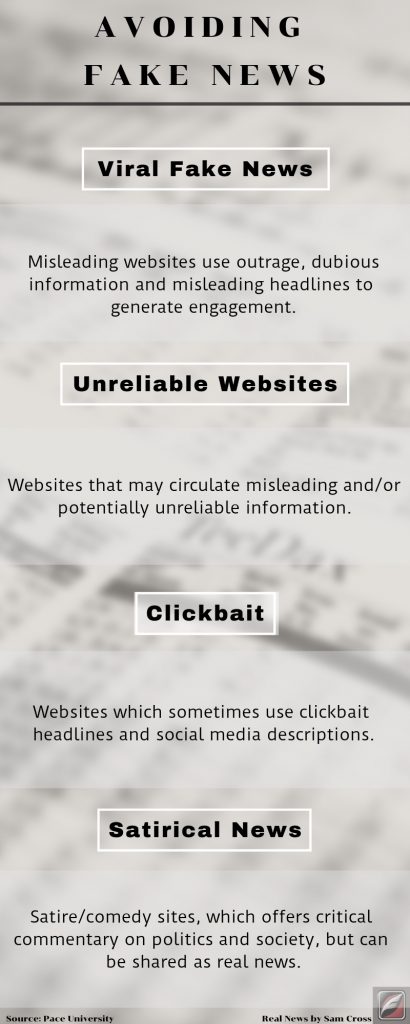Faulty websites give false information, mislead readers from the truth

Around the world, news is obtained through social media, online sites, newspapers, and numerous other sources. As viewers scroll through thousands of perspectives and opinions, getting real today news seems near impossible. In the struggle for the truth the question remains; how can readers tell fake news from real news?
Pace University published a research guide on how to tell the difference between real news and fake news, Jan. 2019. One of the main reasons people visit news websites is to educate themselves about what is happening around the world.
The research guide was originally created by Sarah Cohn, Instructional Services Librarian; she explains why people should care about their news sources.
“You deserve the truth,” the guide suggested. “You are smart enough to make up your own mind – as long as you have the real facts in front of you. If you are writing a research paper, your professor will expect you to vet your sources.
The guide went on to indicate that “if you are planning on voting in an election, you want to read as much good information on a candidate so you can vote for the person who best represents your ideas and beliefs.”
To bring this idea closer to high school or college students, “Fake news will not help you get a good grade or make the world a better place, but real news can.”
English teacher Andrea Donaghe explains why it is important for students to know what real news is.
“It is important for students to be able to know real news so that they are able to discern between it and fake news,” Donaghe said. “There are so many media outlets and social media networks trying to force opinions on young adults (that are still impressionable), that you have to be able to eliminate opinions pieces and rhetoric. When students complete a research paper, something I have done in the past provides a list of sources I call “The Three R’s”-sources that are reputable, respected and reliable. A student is not permitted to cite Perez Hilton or quote a Kardashian in the research paper.”
The best way to avoid fake news is by knowing what news sources can be trusted. Forbes wrote an article on the topic of reliable outlets titled “1o Journalism Brands Where You Find Real Facts Rather Than Alternative Facts”. The article lists the top 10 most trustworthy news sources and why they can be trusted.
Paul Glader, the writer of this article, believes that The New York Times is the most influential news source.
“This is the most influential newspaper in the U.S. in my view,” Glader said. “Its editorial page and some of its news coverage take a left-leaning, progressive view of the world. But the NYT also hews to ethical standards of reporting and the classic elements of journalism in America. It is a leader in business, politics and culture coverage.”
Glader continues by saying The Wall Street Journal is the second most reliable source. The Wall Street Journal focuses mostly on business news.
“The largest circulation newspaper in the U.S., the WSJ made its bones as a business newspaper and pioneered new types of feature writing in American journalism,” Glader said. “The WSJ is still brand X among daily business publications in the world. It has won several Pulitzer Prizes for editorials and columns that feature a clear thesis, backed up by thorough fact-based reporting and bold arguments.”
Regardless of our political beliefs, most of us agree that we need real facts & as accurate of information as possible.
Here are some tips from @Fresno_State‘s Institute for Media & Public Trust for identifying “real” versus “#FakeNews” https://t.co/xwuJ6MnzyB @wordpressdotcom
— Rep. Jim Costa (@RepJimCosta) July 6, 2018
National correspondent for The New York Times Sabrina Tavernise wrote an article on how fake news can make people doubt real news. The article “As Fake News Spreads Lies, More Readers Shrug at the Truth” discusses the impact of fake news.
“The larger problem, experts say, is less extreme but more insidious,” Tavernise said. “Fake news, and the proliferation of raw opinion that passes for news, is creating confusion, punching holes in what is true, causing a kind of fun-house effect that leaves the reader doubting everything, including real news.”
Addie Richardson, ’21, shares what she thinks fake news is and where she finds it.
“I consider fake news to be anything that is meant to be wholly, misleading, or fake,”Richardson said. “I see most fake news online. But I also see it in advertisements and magazines.”
News is all around us and the ability to discern real news from fake news impacts the way we view the world around us. Whether through social media, a newspaper, or online sites, checking facts and sources allows people to be informed without a bias influence.
For more articles related to this topic, read Professionals share importance of First Amendment freedoms and Campus events, athletics shape FC community.





Traci Triplitt • Feb 21, 2019 at 2:19 pm
Informative article John!
Shirley Zhao • Feb 21, 2019 at 12:57 pm
Great article! It’s good for more and more people realize and compare to know which website can give us the true news. The fake news con bring more people to interesting but it will let people ignore the truth.
Kyle Clem • Feb 21, 2019 at 12:44 pm
Great article John! It’s good to know how what websites are more reliable than others these days.
Alyssa • Feb 21, 2019 at 12:43 pm
Great article, John!